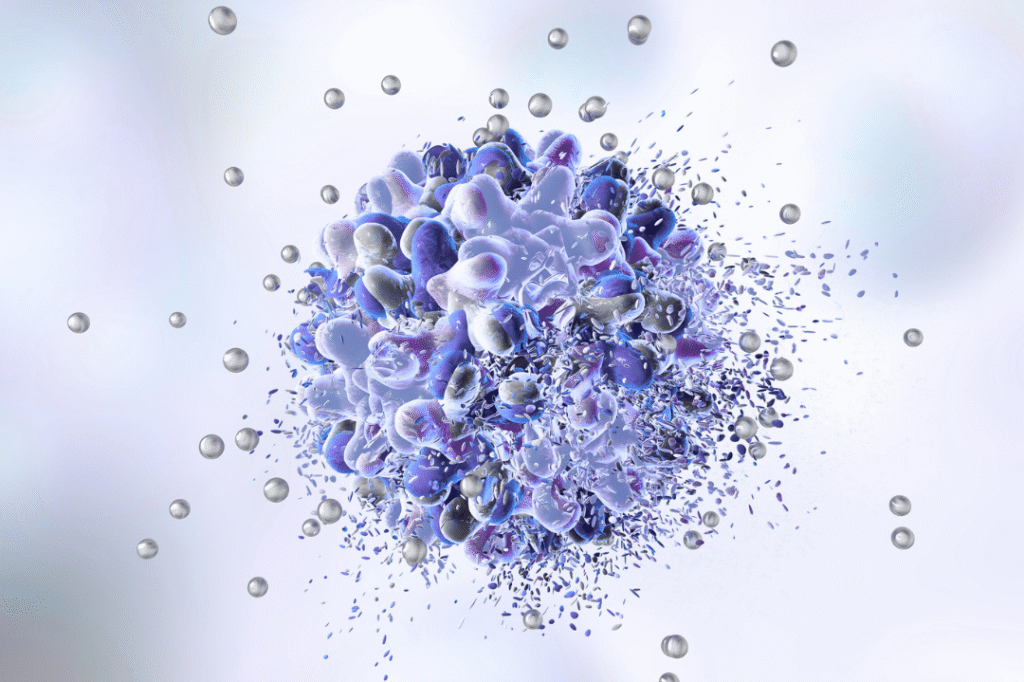Exosomes are tiny bubbles naturally released by our cells. They act like parcels, carrying proteins, lipids, and genetic material that help cells talk to one another. Scientists first studied them in medicine, where they showed potential in wound healing and tissue repair. More recently, they’ve become a topic in skincare, especially around anti-ageing and regeneration.
Why the interest? Because exosomes appear to influence processes central to healthy skin, including collagen production, inflammation control, and repair of damaged tissue. But while the laboratory findings are exciting, most clinical studies are still early. This means exosome skincare is promising but not yet fully proven.

Key takeaway: Exosomes are natural messengers between cells, and they may support repair, hydration, and anti-ageing in skin. Clinical proof, however, is still limited.
What Are Exosomes?
Think of exosomes as small envelopes that cells post to one another. Each envelope contains instructions or resources—proteins, growth factors, or genetic material—that can change how another cell behaves.
In skin, exosomes can come from keratinocytes (the main cells in the epidermis), fibroblasts (which produce collagen and elastin), or stem cells. Their cargo allows them to:
- Encourage wound healing by activating fibroblasts and blood vessel formation.
- Reduce inflammation by shifting immune cells into a calmer state.
- Support collagen and elastin production, which are key to skin firmness and bounce.

Fun fact: Exosomes are so small (30–150 nanometres) that about 500 could fit across the width of a single human hair.
How Exosomes Work in Skin
Exosomes influence the skin through their molecular cargo. Here are the best-studied mechanisms:
- Collagen and elastin synthesis: Fibroblast-derived exosomes can deliver signals that stimulate collagen types I and III, important for skin strength and elasticity.
- Inflammation control: Exosomes can dampen pro-inflammatory signals like TNF-α and boost calming signals, helping wounds or irritated skin recover faster.
- Hydration support: By encouraging production of hyaluronic acid and strengthening the skin barrier, exosomes may help reduce transepidermal water loss (TEWL).
- Pigmentation balance: Some exosomes increase melanin production after UV exposure, while others—such as those from stem cells—may reduce excess melanin and help with uneven tone.
Table 1. What exosomes do in the skin
| Process | Reported effects of exosomes |
| Collagen & elastin | Stimulate fibroblasts to produce more structural proteins |
| Inflammation | Reduce inflammatory cytokines, promote healing |
| Hydration | Boost hyaluronic acid, improve skin barrier |
| Pigmentation | Influence melanocytes to either increase or decrease melanin production |

Exosome function comes from the molecules they carry.
Most evidence comes from lab and animal studies. Human data are limited, so consider exosome skincare as experimental rather than established.
Why Exosomes Appear in Skincare Formulations
In cosmetics, exosomes are being explored for creams, serums, and masks. Their appeal comes from their ability to carry active molecules into the skin, something most traditional ingredients struggle to do effectively.
Formulation considerations:
- Exosomes need to stay intact to work. This means stabilisation is critical, often through freeze-drying or embedding in hydrogels.
- Temperature and storage affect their activity. Room-stable forms are being developed, but stability over time is still a concern.
- Combination approaches are being tested, pairing exosomes with carriers like hydrogels made from adipose tissue or cellulose.
Limitations:
- No exosome product currently has FDA approval. That means products on the market are classified as cosmetics, not medicines, and do not need to prove the same level of safety or efficacy.
- Most studies measure short-term outcomes, often over 4–12 weeks. Long-term effects are largely unknown.
Table 2. Exosomes in cosmetic products
| Formulation type | Why used | Current challenges |
| Creams & serums | Easy application, potential for daily use | Stability and penetration depth |
| Injectable gels | Potentially stronger effect for wound healing or scarring | Regulation and safety testing required |
| Masks & patches | Deliver a concentrated dose | Ensuring even distribution and absorption |
Packaging to prefer
Opaque, air‑restricted, single‑dose formats are ideal. Multi‑use jars invite oxygen and fingertip contamination and are less friendly to delicate vesicles.

Key takeaway: Exosomes are being added to serums and creams because they can carry bioactive molecules. But keeping them stable and effective in real-world products is a major problem.
Sourcing and manufacturing quality
Exosomes only work as intended if they are made well. Their contents vary depending on the type of parent cell, how it was grown, and the conditions under which it was kept. That means the “recipe” is never fixed. To create a product worth using, companies must isolate the vesicles carefully and check their quality at each step.
Cell source and culture
Most cosmetic studies use vesicles from mesenchymal stromal or stem cells (MSCs) taken from fat tissue, umbilical cord, or bone marrow. Vesicles can also be collected from skin cells like keratinocytes. How the cells are grown makes a difference. For instance, using three-dimensional culture systems or adding certain growth factors can increase both the number of vesicles and the quality of their contents. One study found that modifying fibroblast growth factor improved exosome yield and made them more effective at calming inflammation in cell models. In short, the way cells are cultured strongly influences what ends up in the bottle.
Table 1. Typical exosome sources for skincare
| Source | Why used | Advantages | Considerations |
| Adipose-derived MSCs | Similar to skin biology | High yield, linked to repair signals | Donor variation; sterility checks needed |
| Umbilical cord MSCs | Youthful, reliable cells | Consistent growth, robust yield | Must be ethically sourced and documented |
| Bone marrow MSCs | Long research history | Broad immune effects | Lower yield; cargo sensitive to conditions |
| Dermal/epidermal cells | Direct relevance to skin | Barrier and keratinocyte signals | Lower vesicle counts; harder to purify |
| Plant vesicles | Stable and scalable | Fits cosmetic rules | Different biology; effects not the same as human vesicles |
Isolation, characterisation and safety checks
Exosomes are usually separated with centrifugation and filtration. Their size and identity are confirmed using recognised markers like CD9, CD63 and CD81. A safe product should also pass sterility, endotoxin and mycoplasma tests. Shelf life claims should be backed by stability studies.
Table 2. What good quality looks like
| Item | What to expect |
| Source disclosure | Clear information on cell type and donor management |
| Isolation method | Steps that reduce unwanted debris |
| Particle analytics | Size and count measured by standard tools |
| Identity markers | CD9, CD63, CD81 confirmed |
| Purity | Minimal protein or DNA contamination |
| Safety tests | Sterility and contamination checks available |
| Stability | Data to support storage and expiry |
| Packaging | Opaque, sealed, ideally single-use |
Pro tip: If a brand cannot explain where the vesicles come from or how they confirmed identity, be careful about taking their claims at face value.
Artificial exosomes in skincare?
Artificial exosomes are laboratory-engineered vesicles built from biocompatible materials such as lipids or polymers that mimic the structure of a real cell membrane. This allows scientists to customise their contents, loading them with precise actives such as antioxidants, peptides, or growth factors for targeted skin repair. One of their biggest advantages lies in consistency and safety. Because artificial exosomes are created synthetically rather than harvested from donor cells, they carry minimal contamination risk and are generally more stable during storage and formulation—a key factor for skincare products that must remain active over time.
Stability and packaging
Exosomes break down when exposed to heat, oxidation, strong surfactants or extreme pH. To keep them stable, many labs use freeze-drying or cold storage. They are then reconstituted in gentle buffers. Opaque, airtight packaging helps protect them.
Benefits and risks: using exosomes wisely
Exosomes are most promising in situations where the skin needs coordinated repair, such as healing after procedures, restoring a fragile barrier or improving tone when paired with sunscreen.
Potential benefits
Studies in the lab and small clinical trials suggest exosomes can help wounds close more quickly, strengthen the skin barrier, and improve fibroblast activity. Studies show they may affect enzymes like tyrosinase and signalling pathways such as MITF, both of which are key in melanin production. They also seem to carry antioxidant signals that reduce UV-related stress. Most of this evidence comes from preclinical studies, so while results are encouraging, they are not yet definitive for everyday cosmetic use.
Practical risks
Results can vary with source, dose and formulation. Contamination is rare but possible without strict quality control. Some creams or serums can cause irritation due to their base formula, even if the exosomes are safe. Be alert to products that promise to “treat” medical conditions, as those claims go beyond cosmetics. If you are pregnant, breastfeeding, or have autoimmune conditions, seek medical advice first.
Key takeaway: Think of exosome products as supportive care, not stand-alone solutions. Use them alongside sunscreen and a steady routine. Avoid applying them at the same time as strong leave-on acids or benzoyl peroxide.
Exosomes compared with peptides and growth factors
Exosomes, peptides and growth factors are often mentioned together because they all signal to skin cells, but they are different tools.
Table 3. Comparing exosomes, peptides and growth factors
| Feature | Exosomes | Peptides | Growth factors |
| Signal type | Vesicles with proteins, lipids and RNAs | Short amino acid chains | Larger proteins that bind specific receptors |
| Breadth of action | Broad, coordinate multiple repair and immune pathways | Narrow, target-specific | Focused on proliferation and matrix |
| Stability | Sensitive to heat, pH and oxidation | Generally stable in cosmetics | Fragile and easily denatured |
| Evidence | Preclinical and small human studies | Decades of cosmetic use with mixed but supportive data | Clinical use after procedures; limited consumer data |
| Best use | Repair and hydration support | Daily maintenance | Post-procedure recovery under medical care |
Buying checklist
Use these questions to quickly evaluate a product or clinic treatment.
Table 4. Quick screen for exosome skincare
| Question | Strong answer | Red flag |
| Source | Named and documented | Vague terms like “advanced vesicles” |
| Isolation method | Method explained with markers listed | “Proprietary” with no detail |
| Dose per use | Particle count per dose provided | No numbers given |
| Safety | Sterility and contamination data shared | No safety results available |
| Stability | Evidence-based storage and expiry | No supporting data |
| Packaging | Opaque, sealed, single-use when needed | Open jars for delicate formulas |
| Claims | Cosmetic scope like hydration and tone | Disease treatment promises |
Pro tip: Follow storage instructions carefully, especially if refrigeration or mixing is required before use.
Research gaps and next steps
The biggest gap is standardisation. Agreed methods for isolation, dosing and potency would make results easier to compare. New tools like single-vesicle analysis and live imaging are helping scientists track how vesicles move in skin and how long they remain active. Researchers are also exploring engineered vesicles and exosome-like mimics for better targeting and larger-scale production. The next step is large, well-designed clinical trials that measure outcomes people care about: hydration, pigmentation and wrinkle depth over months.
Fun fact
Some exosomes carry proteins that tell immune cells not to engulf them. This allows them to stay in circulation longer, which may partly explain their lasting effects in some studies.
If you’re considering exosome-based skincare, start with realistic expectations.
These products are still new, often costly, and not yet backed by large-scale clinical trials.
Begin by defining your skin goals—whether that’s hydration, texture, or pigmentation. Then discuss options with a qualified skin professional who understands both the science and the regulatory limits of what’s available. When comparing products, look for transparent information about sourcing, formulation, and stability. The market is evolving quickly, so making careful, informed choices will help you avoid disappointment and focus on treatments most likely to support your skin long term.
Talk to you soon!
Dr Bozica
References:
https://www.mdpi.com/2079-9284/12/1/9